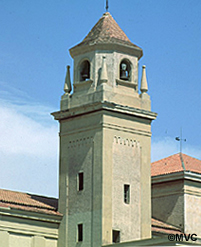 |
| Historic Church of Almería |
History of Almeria
The city of Almeria was founded in 955 by the Arabs, but there are sites that trace their origins to prehistoric times. The hill where the Alcazaba is currently was the subject of the earliest occupation in prehistoric times, likely to be during the Bronze Age. The Roman occupation opened the possibility of permanent habitat to the foundation of the city in 955, based on a small seaside town dependent on the inside (URCI).
During the Muslim period, Almeria reached its peak, especially during the sixth and seventh centuries, after the fall of the Caliphate of Córdoba, becoming a populous center of civilization. The first reliable news about Muslim Almeria dates back to the ninth century, when Abd al-Rahman entrusted coast vigilance to a group of Yemenis in order to prevent the landing of the Normans. Together with the local population, a republic based marine hub, Pechina, was formed and whose prosperity was based on trade, especially in North Africa. Pechina grew larger and acquired the characteristics of a true city and during the ninth and first half of the tenth centuries, Almeria was a merchant and fishing population. After the victorious battle against the rebel Mozarabs, Abd al-Rahman III (912-961), decided to move the capital of the Cora of Pechina, and the watchtower of Pechina received the title of city.
The religious and commercial center, which enfolds the suburbs, Al-Hawd and La Musalla, formed independent cities, where the populations were grouped by origin, beliefs and trades. In 1009-10 Civil War began, and the city took on one of the most flourishing Taifa. With the disintegration of the Caliphate, the death of Hisham II, Jairán seizes the city, independent of Córdoba and converted it into Kingdom of Taifa.
In the eleventh century, Almeria was the international port of Al-Andalus. Silk was exported, bringing fame to the city with its many looms. Subsequently the economic splendor attracted the attention of the Christian Kingdoms, commanding the troops of Alfonso VII. The capture of the city by the Christians occurred in 1147, but ten years later in 1157, the Almohads reconquered the city.
After the 1488 and 1489 campaigns, Almeria passes to Spanish sovereignty, and on December 26, 1489, the Christian troops enter the city. After the capture of the city by the Catholic Monarchs, Almeria suffered abandonment, influenced by its distance from any American trade route. The last hundred years saw both earthquakes and attacks by Barbary pirates and Turks such as, Barbarossa. The first diminished the population and the second terrorized and forced inhabitants to move inland. Especially unfortunate was the earthquake of 1522, which destroyed the city almost completely.
The seventeenth century began with a galloping depopulation with earthquakes, droughts and a coast under constant pirate threat. The Christian repopulation, coming mainly from Jaen, Castilla La Mancha, Levante and Aragon was insufficient and failed to pick up the demography of neither the city nor the province. Despite all this, the mining activity was driven with iron holdings in Filabres, lead in Gádor and marble in Macael. The counterpart is the consequent of large scale logging in the Sierra de Gádor and Almagrera that worsened over the following centuries and contributed significantly to deforestation throughout the territory.
During the Peninsular War (War of Independence), the French occupied the city on March 15, 1810, commanded by Goudinot. The famous resistance fighters, Mena, Villalobos and Arostegui, organized a resistance, and in 1812, the French withdrew from Almeria defeated by Arapiles. In 1814 Fernando VII returned to power and with it the absolutism and the repeal of the Courts of Cadiz in 1812.
In 1824, a group of soldiers from Gibraltar, nicknamed “the coloraos” by the tone of their coats, landed in Almeria with the intention to proclaim freedom and restore the constitution of 1812, but 22 of them were shot by the absolutists. Years later, a monument was raised in honor of the men which was lovingly called, the “pingurucho” and was also the subject of controversy, destroyed in 1943 during the military dictatorship for the first visit of General Franco to Almeria. It was not restored until 1987.
The nineteenth century saw geopolitical, urban and structural developments. Liberals, once they were made with the government of Madrid, promoted an administrative restructuring of the country, of which the current born provinces were born. It was thanks to the efforts of Count Ofalia, who acquired independent administration from the old Kingdom of Granada by decree of 1834.
The city of Almeria has undergone many important changes during the twentieth century, giving way to large buildings in the historical center that has marred its traditional image.